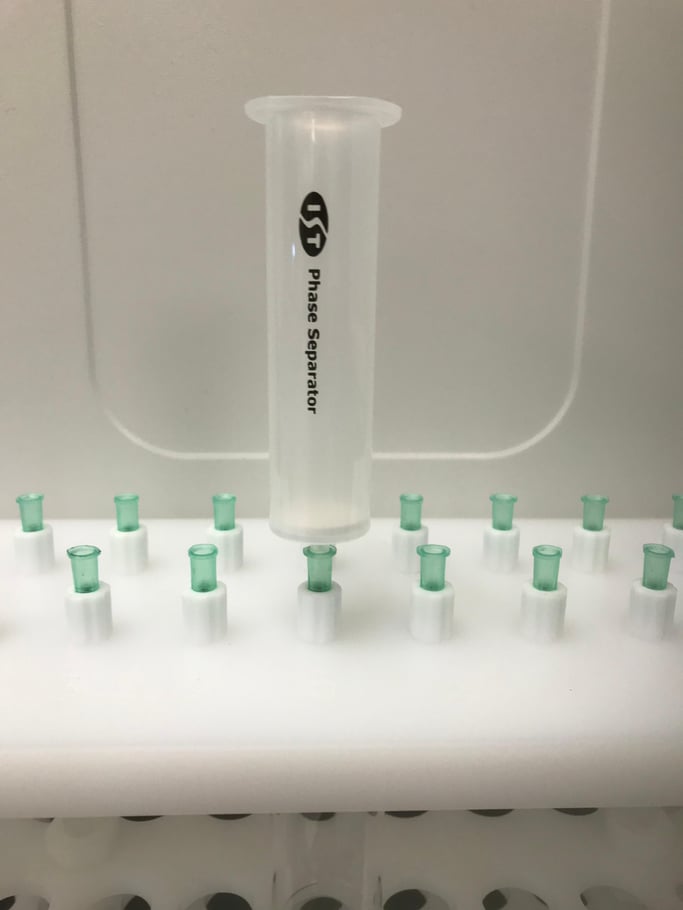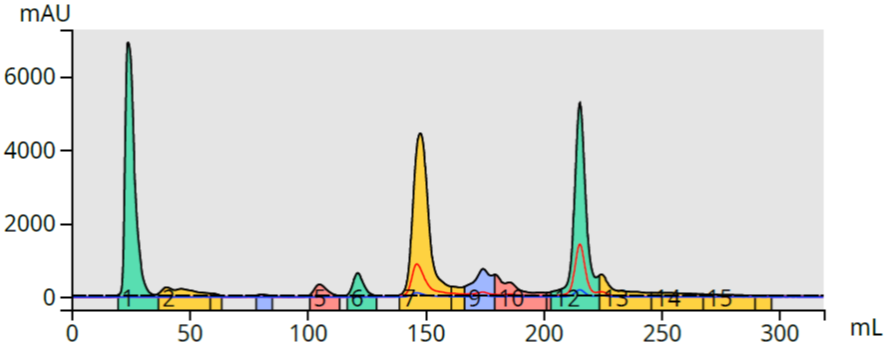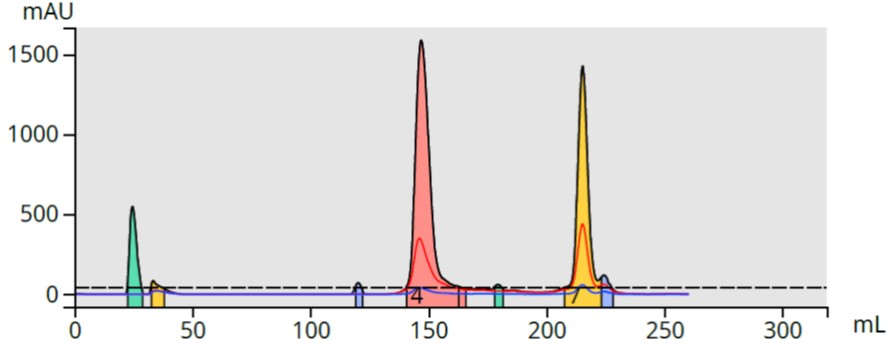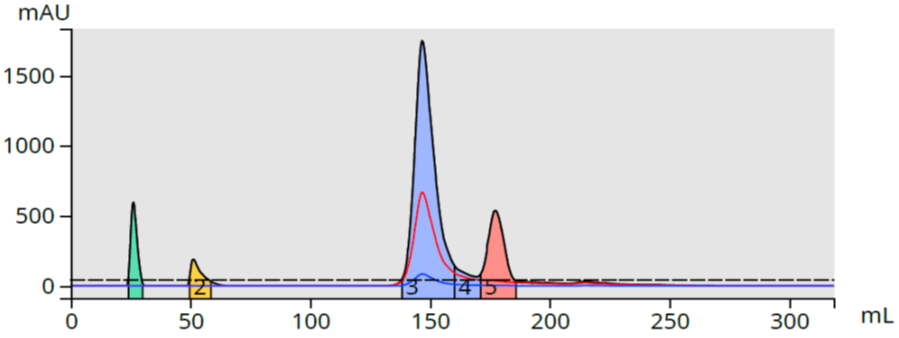Wouldn’t it be nice if your reactions only created your desired product? Of course the answer is yes, but that is not the reality of synthetic chemistry. Because our chemical reactions yield multiple components, they need work-up and purification to isolate the desired compound.
The post synthesis work-up and purification workflow journey can be arduous and long, depending on synthetic conditions and product chemistry.
The typical workflow involves many steps…
- -Reaction quench
- -Reaction mix extraction with separatory funnel (3x)
- -Organic layer water removal with magnesium sulfate or sodium sulfate
- -Evaporation/concentration with rotary evaporator
- -TLC or HPLC-MS
- -Flash purification (normal- or reversed-phase)
- -Collected product fraction evaporation
- -Product purity analysis, yield determination
When the reaction solvents are polar and high boiling (e.g. DMSO, DMF, NMP), normal-phase chromatography is challenged due to these solvents’ strong displacement effect so extraction with an immiscible solvent is needed to remove the reaction product from the reaction solvent. To achieve immiscibility, sometimes water is added to the polar reaction solvent followed by dichloromethane (DCM) to create a biphasic mixture. The reaction product hopefully is lipophilic enough to be extracted out of the aqueous polar phase by the DCM then collected using a separatory funnel.
Did you know that separatory funnel use requires as many as 22 steps? In short, the biphasic mixture is mixed or swirled lightly to ensure maximum reaction mix/DCM contact while minimizing emulsion formation. After mixing, the separatory funnel is tilted so that the stem is pointed up and away from the chemist and the stopcock turned to allow release of any generated gas or pressure. After two or three of these venting sessions, the DCM layer is allowed to settle and is slowly collected as the chemist monitors the biphasic interface. This process is repeated two or more times to fully extract the product. After extraction, the DCM is either evaporated or concentrated in preparation for flash purification, typically using rotary evaporation. This process can take an hour or more to accomplish, depending on volume and sample complexity.
Though tried-and-true, improvements to this workflow exist. Instead of expensive, breakable glass separatory funnels which require cleaning after use and venting to remove any generated extraction gasses, I prefer disposable/recyclable polypropylene phase separators from Biotage to reduce extraction time and eliminate vessel clean-up.
Likewise, the ubiquitous rotary evaporator also requires attention to detail…
- -Evaporation temperature and its control
- -Sample volume
- -Vacuum level and its control
- -Vessel rotation speed
- -Vessel depth in heating bath
- -Condenser temp
- -Cold finger maintenance
- -Bumping
So, for evaporation I prefer a Biotage® V-10 Touch, a product I have mentioned in previous posts, because of its simplicity and lack of constant vigilance by the chemist.
Well, enough with the marketing pitch. This post describes an improved synthetic workflow where I used both products (phase separator and V-10 Touch) to extract my synthetic product and evaporate the solvent for purification.
My reaction, I thought, would be a simple amide synthesis – succinic acid + benzylamine (2 eq) in DMSO using a Biotage® Initiator+ microwave at 200 °C for 15 minutes to create N,N’-dibenzylsuccinamide, Figure 1. The results, however, would prove otherwise as those more experienced in organic synthesis would predict.

Figure 1. Succinic acid + benzyl amine reaction
My original purification plan was normal-phase flash chromatography. To determine the best solvent ratio/gradient for this purification I chose TLC but in order to get a fair analysis I needed to remove my product from the DMSO. So, I transferred 0.5 mL of the reaction mixture into a 20-mL scintillation vial and added ~5-mL of DI water. This caused the solution to become milky white with an orange oil floating on top. To this aqueous mix I added ~3 mL DCM, capped and shook the vial, not being overly concerned about any emulsions or gas evolution.
I poured the extraction mixture into a 25-mL Biotage® Phase Separator I had attached to a Biotage® Gravity Rack and collected the orange DCM extract into a separate 20-mL scintillation vial in less than 1 minute. I then added ~3 mL more DCM and collected it in the same vial, Figure 2.

Figure 2. Gravity rack with phase separator
I tried to find suitable normal-phase purification conditions with a range of hexane/ethyl acetate mobile phases using TLC but the product did not move from the origin. When I encounter these situations, I typically turn to reversed-phase flash chromatography rather than trying to develop a normal-phase DCM/MeOH solution. In my experience, reversed-phase usually provides a better separation, is easier to perform, and is more environmentally friendly.
To evaluate my reaction’s success, I injected 0.1 mL of the crude DMSO reaction into a 12-gram Biotage® Sfär C18 column. The purification method was a simple, un-optimized 10-100% methanol gradient and produced an excellent separation of several compounds, Figure 3.

Figure 3. Reversed-phase flash chromatography of the crude reaction mixture in DMSO prior to extraction. Peak 1 is DMSO, peaks 7 (yellow) and 12 (green) are likely the product and a major by-product.
As you can see in the chromatogram, there are two large peaks (not including the unretained DMSO peak) and several smaller peaks. Great, the chromatography method worked well but at this point I did know which peak was my product? It also raised my curiosity as to the other product's identity.
Since I had already extracted a portion of the crude mix with DCM, I wanted to see if the extraction process removed any of the impurities, again using flash chromatography. Since DCM is not a great reversed-phase injection solvent, I evaporated the DCM and re-dissolved the dried product in 2-mL of 1:1 acetone/methanol in preparation for reversed-phase chromatography.
I injected 0.1 mL of this solution into the C18 column and the chromatography showed that several impurities were removed but the two major peaks remained, Figure 4.

Figure 4. Reversed-phase flash chromatography of the reaction mixture's DCM extract. Most of the small by-products were removed but the two main reaction products remained.
Based on earlier work using a strong cation exchanger (ISOLUTE® SCX-2) to trap, purify, and release a different synthetic amide, I followed the same course with this reaction. My theory being that if I synthesized my target amide compound, it, as well as other basic by-products, should bind to the cation exchanger but neutral compounds would not.
So, I mixed 1-gram of SCX-2 with the remaining acetone/methanol dissolved extract and evaporated the mixture in a 20-mL scintillation vial. The dried solid was packed into an empty 10-gram Sfär DLV (dry load vessel) and attached to my equilibrated C18 column. The resulting chromatography showed complete removal of not just the underlying minor impurities but also one of the major peaks, Figure 5. This told me I created my amide product and that the other major product was not basic and quite likely N-benzylsuccinimide.

Figure 5. SCX scavenged reaction mixture showing full removal of the later eluting major reaction product.
HPLC-MS of my crude reaction mixture (not shown) indicated I did make my product, N,N’-dibenzylsuccinamide (MW 296) which was trapped by the SCX dry load media and the imide, N-benzylsuccinimide (MW 189) which did not bind to the ion exchanger. To recover scavenged products from SCX methanol/1% ammonium hydroxide is very effective.
The results of this experiment show that excellent sample work-up and purification results can be quickly accomplished using inexpensive, disposable/recyclable phase separator cartridges, an automated solvent evaporator, and an appropriate scavenger media.
- -Synthesis - 15 minutes
- -Extraction with DCM - ~1 minute
- -Evaporation on the V-10 Touch -~5 minutes per cycle, 10 minutes total
- -Flash chromatography - 10 minutes per run, 20 minutes total
-Synthesis, extraction, evaporation, and purification in ~3/4 hour; fast and efficient workflow.
Interested in learning more about Biotage work-up products? Please download our work-up products brochure.

 Organic Workflow
Organic Workflow Peptide Workflow
Peptide Workflow Scale-Up Flash Purification
Scale-Up Flash Purification  Sample Preparation
Sample Preparation Biomolecule Purification
Biomolecule Purification Oligo synthesis
Oligo synthesis Scavengers and Reagents
Scavengers and Reagents Service & Support
Service & Support Accessories & Spare parts
Accessories & Spare parts Investors
Investors Reports & News
Reports & News The Share
The Share Corporate Governance
Corporate Governance Calendar
Calendar Sustainability
Sustainability Our Offering
Our Offering Our History
Our History Our Locations
Our Locations Leadership
Leadership